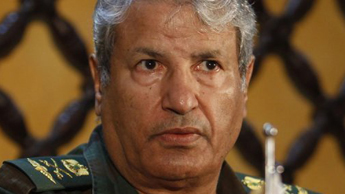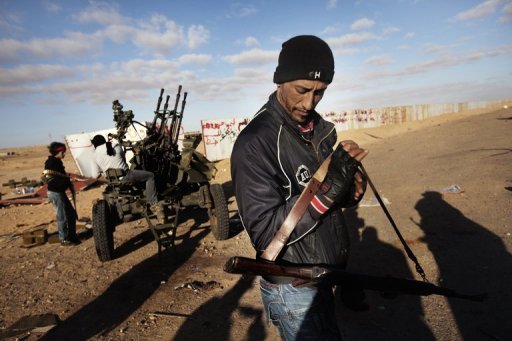Gaddafi’s gone and Libyans must come together – but how?
Okay, it’s the end of the long, loud road to revolution. Muammar Gaddafi is dead and now we start the longer, laborious road to democracy – or some form of it – in Libya.
A day after Gaddafi’s death, I’ve already done my first “Libya: What next?” segment and I was surprised by how tempered my reaction was to the news we’ve been awaiting all these months.
After all that time breathing the free air of Benghazi, discussing the much anticipated end of Gaddafi over Italian espressos as the rebels fought pitched battles for Misrata, the end, when it came, was not as euphoric as I’d imagined.
Don’t get me wrong, I don’t want to underestimate or downplay the momentous victory that ordinary Libyans have achieved risking - and often sacrificing - their lives to oust a dictator who was invincible for 41 years.
I can’t begin to imagine what went through Salem Ziu’s mind when he heard the news of Gaddafi’s death. Photographs of Ziu’s brother, Mehdi Ziu, are plastered on walls across Benghazi as we speak, proclaiming him a “shaheed” or martyr.
On February 20, Mehdi rammed his explosives-laden car into Gaddafi’s barracks – or the katiba – in Benghazi, tearing a hole in the sprawling complex wall and instantly incinerating himself.
 When I interviewed Salem, a month later, the younger Ziu brother was weary, dry-eyed, recounting the story with the precision of a police detective, his grief settled into a dull pain.
When I interviewed Salem, a month later, the younger Ziu brother was weary, dry-eyed, recounting the story with the precision of a police detective, his grief settled into a dull pain.
Did Salem cry out with joy when he heard the news of Gaddafi’s death? Did he feel his brother’s sacrifice had been vindicated? Did he wish his brother was around to hear the news?
Mehdi Ziu was just one of so many shaheed posters adorning the walls of Benghazi. To all the Libyans who braved it, who died for it, and who volunteered their time and expertise for the cause, you did it.
To the ordinary Libyans, so euphoric, so helpful, so hopeful who rose up that fateful February night, I say mabrook, tahani, congratulations – you did it.
You did it while so many sceptics comfortably ensconced in their safe, democratic worlds questioned why their governments should help any people trying to overthrow a tyrant. You showed them.
Raining down on the party
So Gaddafi’s gone and there are parties on the streets of Libya’s cities. Now I hate to be the one to rain down on a party, but there have also been some very disquieting moments during the Libyan uprising and I think it best we take a look at them right now, coolly and calmly, before we rush to judge Libya’s democratic transition track record.
Top disquieting moment of October 20, the day Gaddafi died: Watching the mobile phone videos of his final hours in Sirte. They’re graphic, grotesque, disturbing and raise troubling questions.
For one, it’s not at all clear that Gaddafi was killed in combat. Video footage of a bloodied, wounded but alive Gaddafi being manhandled by shouting NTC (National Transitional Council) fighters trigger involuntary sympathy for man you never thought you’d have any sympathy for.
Follow that up with still more footage of his body being apparently dragged through the streets of Sirte and that raises the question: was Gaddafi summarily executed?
The NTC does its NTC routine
These videos were already circulating on the Internet and they were being broadcast on TV stations Thursday as the NTC took its time – hours, nail-biting hours – confirming the death.
When they did, they did not succeed in coming with a consistent official version of the events.
Gaddafi was shot in crossfire and died en route to a Misrata hospital, said interim Libyan Prime Minister Mahmoud Jibril. Hours later, Jibril suggested he was killed by a stray bullet on the way to the hospital.
But before that version went out, some NTC officials – who declined to be named – admitted that Gaddafi was lynched by a mob. That version is conceivable if you look at those video clips.
Former Islamist foes turned allies
For those of us who have been covering the Libyan uprising since the NATO campaign began in March, this came as no surprise, alas.
There’s been a serious command, control and communication problem between the NTC officials in Benghazi and the fighters on the ground, who are mostly irregular, untrained civilians turned overnight warriors.
There’s also a question of all the rebel brigades and militia groups that do not strictly follow the command of the National Liberation Army as it’s called. This became very apparent in July, when a senior National Liberation Army general, General Abdel Fatah Younus was killed by his own.

They couldn’t crank out a consistent, official version of how and why Younus was killed. My sources told me he was killed by a rogue brigade fighting with the rebels – and I tend to believe them.
This raises the whole business of rogue brigades and the sundry, sometimes alarming mix of fighters within the NTC’s ranks.
The mix, as US officials well know, includes some Islamists who’ve done the jihadi trail from fighting the Soviets in Afghanistan to joining the insurgency in Iraq.
Many of them were part of the now-disbanded Libyan Islamist Fighters Group (LIFG) which has a spot on the US State Department list of foreign terrorist groups with al Qaeda links.
The former LIFG emir, Abdel Hakim Belhaj, is the man currently in charge of the military committee responsible for keeping order in Tripoli.
Last night, I watched keenly as he appeared at a Tripoli press conference, talking about “the challenge of building a new Libya”.
Belhaj has his own personal challenge: getting rival militias to budge out of Tripoli.
Turning heroes back into ordinary men
These days, the former LIFG fighters denounce al Qaeda and reaffirm their commitment to a democratic Libya. That would probably be the democratic Islamic nation of Libya and from my conversations in the conservative eastern city of Benghazi, I have little doubt that many Libyans would support an Islamic state. But when it comes to defining an Islamic state, the devil, as we all know, lies in the detail.
The big questions though are how do you get these brigades to disband? How do you convince young men who have turned into national heroes with battlefield adrenalin levels to return to their mundane everyday jobs?

That’s just on the military front. Don’t expect the political process to be a smooth one.
Getting Libyans to unite now that the anti-Gaddafi glue has unstuck might be easier said than done.
While I was in Benghazi, I was struck by the levels of distrust between easterners from Cyrenaica and the westerners from Tripolitania.
The east of course has long been the anti-Gaddafi bastion, it has borne the brunt of the former dictator’s anti-Islamist crackdowns and it’s still bristling under the economic deprivation during the Gaddafi years.
But while Benghazi was the de facto rebel capital during the uprising, western towns like Misrata and Zawahriya put up a brave, bloody fight against Gaddafi loyalists.
The bitter regional chasm opened the very next day after Gaddafi’s death. Apparently, the much-awaited NTC announcement that Libya is liberated will not be held in Tripoli this weekend, but in Benghazi.
There’s been some bitter behind-the-scenes wrangling about the venue choice for this announcement.
On this round, the east has won. I sincerely hope this will not be a victor’s peace. That, as we all know, is a peace to end all peace.




3 Comments
Post new comment